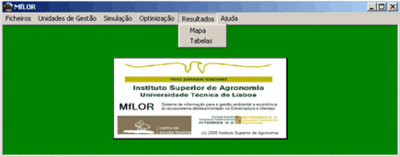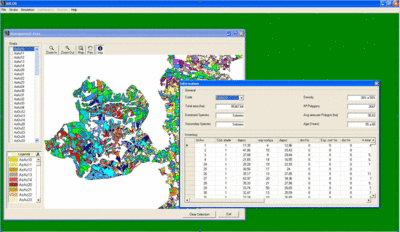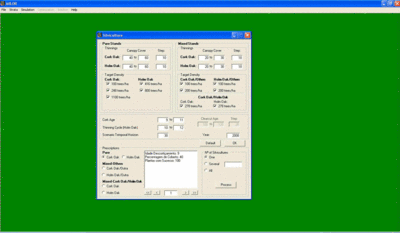Difference between revisions of "MfLOR"
Joseborges (Talk | contribs) (→Typical spatial extent of application) |
Ola Eriksson (Talk | contribs) |
||
| (29 intermediate revisions by 3 users not shown) | |||
| Line 9: | Line 9: | ||
MfLOR is a tool that may support both cork and holm oak forest management planning and scenario analysis. | MfLOR is a tool that may support both cork and holm oak forest management planning and scenario analysis. | ||
| − | [[Category: | + | [[Category:Decision support system]] |
| + | [[Category:Portuguese DSS]] | ||
| + | [[Image:presentation.gif |thumb|400px| MfLOR menu options and logo]] | ||
__TOC__ | __TOC__ | ||
| Line 37: | Line 39: | ||
=== Capability to support decision making phases === | === Capability to support decision making phases === | ||
| − | * Intelligence ( | + | * Intelligence |
| − | * Design ( | + | The GUI helps the user define the scenario analysis/management planning problem (e.g. by identifying goals). |
| − | * Choice | + | |
| − | * Monitor | + | * Design |
| + | The GUI provide guidance to define the model that best addresses the decision-maker goals (e.g by identifying activities or decision variables, objectives and constraints). | ||
| + | |||
| + | * Choice | ||
| + | The LP solver and the GUI help select strategies. | ||
| + | |||
| + | * Monitor | ||
| + | No support is provided. | ||
== Data and data models == | == Data and data models == | ||
| Line 51: | Line 60: | ||
The system may use both individual tree level data and stand level data from sample plots. It uses gis information (vectorial). It may further use financial information (e.g. prices, discount rate) | The system may use both individual tree level data and stand level data from sample plots. It uses gis information (vectorial). It may further use financial information (e.g. prices, discount rate) | ||
| + | |||
| + | [[Image:area.gif |thumb|400px| MfLOR inventory and geographical data display]] | ||
| Line 60: | Line 71: | ||
=== Forest models === | === Forest models === | ||
| − | + | ||
| + | The system integrates new cork and holm oak growth and yield models – SUBER v. 4.0. This model provides estimates of cork and timber yields. It further provides estimates of carbon stocks in the tree above the ground. | ||
== Decision Support == | == Decision Support == | ||
| Line 66: | Line 78: | ||
=== Definition of management interventions === | === Definition of management interventions === | ||
| − | The user may define all cork and holm oak silviculture parameters e.g. harvest (timing of clearcut if it is a regular stand, timing and intensity of thinnings, timing of cork extraction) and regeneration | + | The user may define all cork and holm oak silviculture parameters e.g. harvest (timing of clearcut if it is a regular stand, timing and intensity of thinnings, timing of cork extraction) and regeneration parameters. The prescription writer provide an interface for the user to input this information and it automates the generation of management options. |
| + | |||
| + | [[Image: prescr.gif |thumb|400px| MfLOR interface to define management options]] | ||
| + | |||
=== Typical temporal scale of application === | === Typical temporal scale of application === | ||
| Line 76: | Line 91: | ||
**strategic decisions | **strategic decisions | ||
* Management function | * Management function | ||
| − | * | + | * Planning decisions |
**organizing decisions | **organizing decisions | ||
**command decisions | **command decisions | ||
| Line 91: | Line 106: | ||
=== Types of outputs === | === Types of outputs === | ||
| − | + | Results are reported in tables and in maps. | |
| + | |||
| + | [[Image:sol.gif |thumb|400px| MfLOR solution report interface]] | ||
=== Spatial analysis capabilities === | === Spatial analysis capabilities === | ||
| − | |||
| − | |||
| − | |||
| − | |||
| − | + | The system has spatial reporting capabilities. Yet it does not include spatial analysis functionalities. It provides standard data import/export formats (GIS, spreadsheet, relational database) | |
| − | + | ||
== System == | == System == | ||
=== System requirements === | === System requirements === | ||
| − | * | + | |
| − | * Other software needed | + | * Hardware requirements: 2 GHz Pentium IV, 1024 Mb of RAM, 250 Mb of hard disk, CD-ROM reader |
| − | * Development status | + | * Operating Systems: Windows 2000, Windows XP or Windows Vista |
| + | * Other software needed: the user does not need to acquire additional software. | ||
| + | * Development status: completed | ||
=== Architecture and major DSS components === | === Architecture and major DSS components === | ||
| − | + | ||
| + | MfLOR is a desktop application with a modular structure. It was developed with software Ms VB.NET. | ||
| + | |||
| + | The system includes a MS Access 2003 relational database (INfLOR 2.1), a simulator with cork and holm oak growth and yield models – SUBER v. 4.0, a prescription writer, an LP matrix generator, and a report generator. It further includes freeware (GIS and LP solver). A GUI ties all modules together to provide the user-schema. | ||
=== Usage === | === Usage === | ||
| Line 117: | Line 135: | ||
=== Computational limitations === | === Computational limitations === | ||
| − | + | ||
| + | Run time is impacted mostly by the number of prescriptions (LP variables). This depends on a) the number of stands b) the length of both the planning horizon and the planning period and c) the flexibility when defining prescriptions. | ||
=== User interface === | === User interface === | ||
| − | + | ||
| + | MfLOR has a standard Windows GUI. Thoughtful use of the system requires some forest management planning background. | ||
=== Documentation and support === | === Documentation and support === | ||
| Line 129: | Line 149: | ||
=== Installation === | === Installation === | ||
| − | + | ||
| − | + | Simple Windows guided installation. | |
| − | + | ||
==References== | ==References== | ||
Latest revision as of 08:54, 14 October 2012
General System description
System name: Montado ecosystem management decision support system
Acronym: MfLOR
Brief overview
MfLOR is a tool that may support both cork and holm oak forest management planning and scenario analysis.Contents
Scope of the system
The tool in its current version provides information to support scenario analysis applied to cork oak forest ecosystems in Southern Portugal.
System origin
The system was developed in 2007/2008 by the Centre of Forest Studies of Instituto Superior of Agonomia (CEF/ISA) of the Technical University of Lisbon in the framework of Project INTERREG IIIA “Desarrollo de un sistema de información para la gestión ambiental y económica del ecosistema dehesa/montado en Extremadura y Alentejo. 2ª Fase” and by Project PTDC/AGR-CFL/64146/2006 “Decision support tools for integrating fire and forest management planning” funded by the Portuguese Science Foundation.
MfLOR is used by the Portuguese Ministry of Agriculture Regional Office of Alentejo (DRAPAL) to support cork and holm oak regional scenario analysis. The cork and holm oak covertypes extend over an area of approximately 1 million ha.
Support for specific issues
The system was designed so that it might support both management planning and regional analysis. Its current implementation provides information about potential timber, cork and revenues flows as well as about carbon stocks in an area of about 1 million ha in Southern Portugal. The user may specify the time period and may assess tradeoffs between target flows and stocks.
Support for specific thematic areas of a problem type
- Silvicultural
- Conservation
- Restoration
- Development choices / land use zoning
- Policy/intervention alternatives
- Sustainability impact assessment (SIA)
Capability to support decision making phases
- Intelligence
The GUI helps the user define the scenario analysis/management planning problem (e.g. by identifying goals).
- Design
The GUI provide guidance to define the model that best addresses the decision-maker goals (e.g by identifying activities or decision variables, objectives and constraints).
- Choice
The LP solver and the GUI help select strategies.
- Monitor
No support is provided.
Data and data models
Typical spatial extent of application
The system may be used both for management planning (stand and/or landscape-level) and regional analysis. It may address both single and multiple decision makers contexts (yet it does not include specific tools to conduct negotiation processes)
Forest data input
The system may use both individual tree level data and stand level data from sample plots. It uses gis information (vectorial). It may further use financial information (e.g. prices, discount rate)
Type of information input from user (via GUI)
The user may input a) expert knowledge to define prescriptions/strategies, b) simulation period, c) financial data and d) goals and production objectives
Models
Forest models
The system integrates new cork and holm oak growth and yield models – SUBER v. 4.0. This model provides estimates of cork and timber yields. It further provides estimates of carbon stocks in the tree above the ground.
Decision Support
Definition of management interventions
The user may define all cork and holm oak silviculture parameters e.g. harvest (timing of clearcut if it is a regular stand, timing and intensity of thinnings, timing of cork extraction) and regeneration parameters. The prescription writer provide an interface for the user to input this information and it automates the generation of management options.
Typical temporal scale of application
MfLOR was designed to support strategic management planning and scenario analysis.
Types of decisions supported
- Management level
- strategic decisions
- Management function
- Planning decisions
- organizing decisions
- command decisions
- decision making situation
- unilateral
- collegial
Decision-making processes and models
MfLOR uses a linear programming model.
Output
Types of outputs
Results are reported in tables and in maps.
Spatial analysis capabilities
The system has spatial reporting capabilities. Yet it does not include spatial analysis functionalities. It provides standard data import/export formats (GIS, spreadsheet, relational database)
System
System requirements
- Hardware requirements: 2 GHz Pentium IV, 1024 Mb of RAM, 250 Mb of hard disk, CD-ROM reader
- Operating Systems: Windows 2000, Windows XP or Windows Vista
- Other software needed: the user does not need to acquire additional software.
- Development status: completed
Architecture and major DSS components
MfLOR is a desktop application with a modular structure. It was developed with software Ms VB.NET.
The system includes a MS Access 2003 relational database (INfLOR 2.1), a simulator with cork and holm oak growth and yield models – SUBER v. 4.0, a prescription writer, an LP matrix generator, and a report generator. It further includes freeware (GIS and LP solver). A GUI ties all modules together to provide the user-schema.
Usage
Government use (Portuguese Ministry of Agriculture Regional Office of Alentejo (DRAPAL))
Computational limitations
Run time is impacted mostly by the number of prescriptions (LP variables). This depends on a) the number of stands b) the length of both the planning horizon and the planning period and c) the flexibility when defining prescriptions.
User interface
MfLOR has a standard Windows GUI. Thoughtful use of the system requires some forest management planning background.
Documentation and support
The graphical user interface provides access to the MfLOR users' manual:
Borges, P., S. Marques., M. Marto e J. G. Borges. 2008. O Sistema de Apoio à Decisão em Análise de Cenários em Montados de Sobro e Azinho no Alentejo, MfLOR, Documento Técnico, 01/08, FORCHANGE/LEAF/CEF/ISA, Lisboa, Portugal
Installation
Simple Windows guided installation.
References
Cited references
External resources
Borges, P., S. Marques, J. G. Borges e M. Tomé. 2008. Scenario analysis applied to cork and holm oak forest ecosystems in Southern Portugal, In: Palahi, M., Birot, Y., Bravo, F. and Gorris, E., (Eds) Modelling, valuing and managing Mediterranean Forest ecosystem for non-timber goods and services, EFI Proceedings 57: 49-56.



